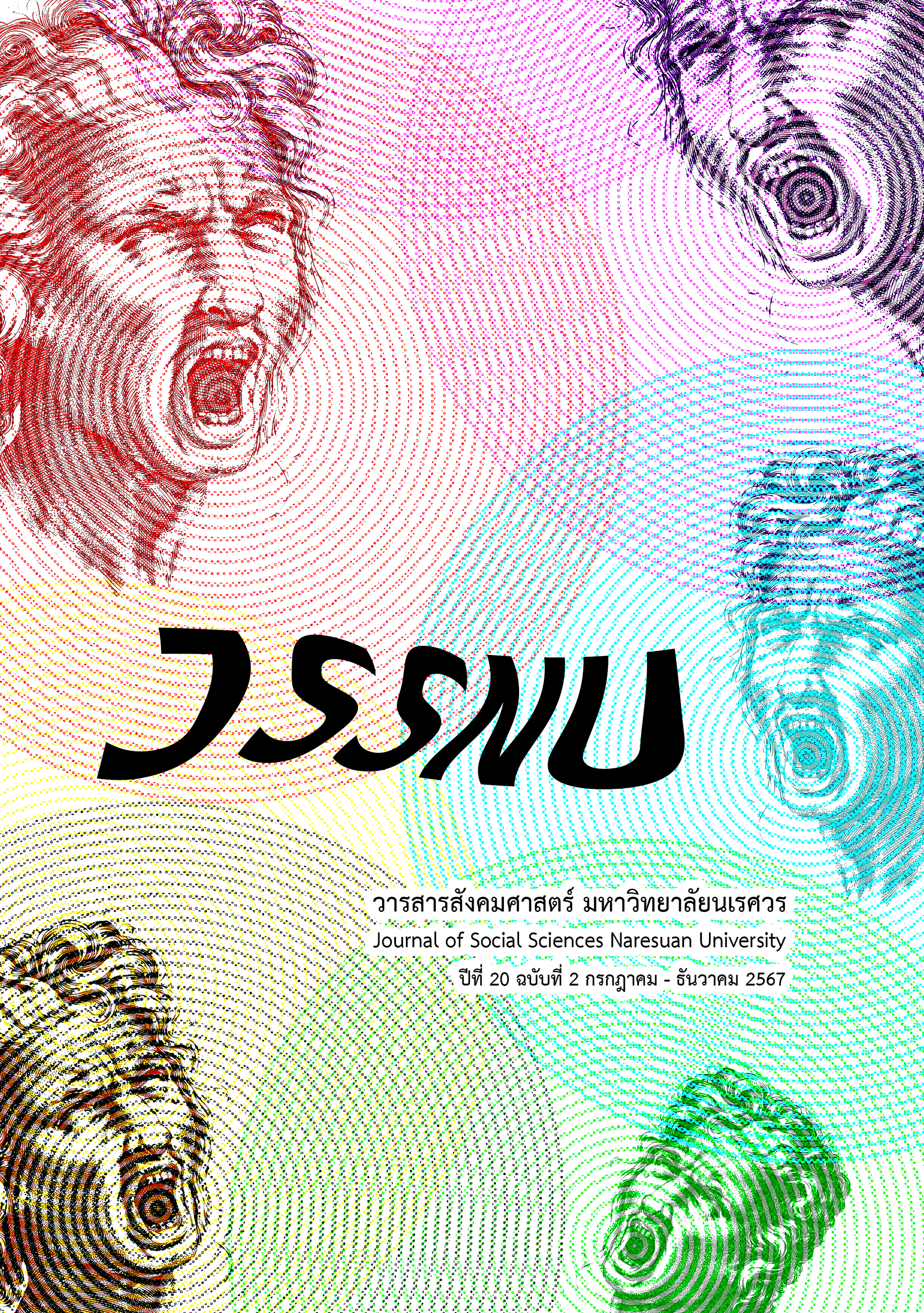Voices of Low-income Tenants: Uncovering Unheard Narratives in Housing
Main Article Content
Abstract
This research article explores the often-overlooked lives of low-income tenants, highlighting their experiences in a landscape where academic and policy discussions predominantly focus on initiatives that support middle-and high-income homeowners. Using the political economy of housing as a framework, the article reveals how both government and business sectors prioritize home buying and selling-driven by profit motives and expectations of economic growth, while neglecting the needs of low-income individuals who are unable to secure housing loans. Consequently, the voices of low-income tenants remain unheard. The research employs two methods: in-depth interviews and participant observation, focusing on two distinct locales-the area behind the Bangbua Community Housing Project and the Wat Duangkhae Communities. The findings highlight three key issues. Firstly, the pathways to becoming tenants in these areas are explored, highlighting the necessity for affordable rental accommodation in proximity to places of employment. Secondly, the persistence of low-cost rental units in urban areas is investigated, showing that these units are typically located in zones with limited access to major thoroughfares, making them unsuitable for high-end housing developments. Lastly, the lived experiences of tenants demonstrate their lack of access to and benefit from existing housing policies. The article suggests the government launch alternative housing policies that support affordable rental accommodations.
Downloads
Article Details

This work is licensed under a Creative Commons Attribution-NonCommercial-NoDerivatives 4.0 International License.
References
Aalbers, M. B., & Christophers, B. (2014). Centering housing in political economy. Housing, Theory and Society, 31(4), 373-394.
Archer, D. (2012). Baan Mankong participatory slum upgrading in Bangkok, Thailand: Community perceptions of outcomes and security of tenure. Habitat International, 36(1), 178-184.
Boonyabancha, S. (2005). Baan Mankong: Going to scale with “slum” and squatter upgrading in Thailand. Environment and Urbanization, 17(1), 21-46.
Changmongkholgan, T. (2006). Saphap kan yu a-sai khong phu khabkhi rot samlothib: Koranisuksa tanchumchon soi waddan tambon samrongnue changwat samutprakkan (in Thai). [Living conditions of pedicab riders: A case study of Waddan Community, Samrongnue Subdistrict, Samutprakan Province. Bangkok: Chulalongkorn University.
Chouyming, T. (2019). Rok chitttaweth khong krum prashakon khon raiban nai khet krungthepmahanakhon (in Thai). [Mental disorders of homeless in Bangkok]. Journal of Social Research, 42(2), 107-152.
Community Organization Development Institute (CODI). (2019). Secure land, housing and sustainable livelihoods for Thailand’s rural landless poor. Retrieved June 20, 2024, from https://en.codi.or.th/baan-mankong-rural/
Desmond, M. (2018). Heavy is the house: Rent burden among the American urban poor. International Journal of Urban and Regional Research, 42(1), 160-170.
Elinoff, E. (2021). Citizen designs: City-making and democracy in Northeastern Thailand. Honolulu: University of Hawaii Press.
Engels, F. (1935). The housing question. New York: International Publishers.
Ministry of Social Development and Human Security. (2017). Yutthasat kan phatthana thiu-asai raya yisip pi 2560-2579 (in Thai). [Housing development plan for 20 years (2017-2036). Bangkok: Ministry of Social Development and Human Security.
National Housing Authority (NHA). (1992). Rainganphol buangtom kan sanruad “khonchon muang” (in Thai). [Preliminary report of the survey “urban poor”]. Housing Periodical Magazine, 1(1), 1-74.
Pattillo, M. (2013). Housing: Commodity versus right. Annual Review of Sociology, 39, 509-531.
Phiromthong, P. (2015). Padchai thi mi itthiphol cheung buak to kan tadsinchai shao apartment khong phu boriphok nai Kungthepmahanakhon (in Thai). [Factor positively impacting decision to rent apartments of consumers in Bangkok]. Bangkok: Bangkok University.
Pholsing, A. (2017). Saphap kan yu a-sai khong phanakngan tham kham sa-ad thi pen lukchang borisat rabmao tham kham sa-ad: Koranisuksa phanakngan thi pen lukchang khong Chulalongkorn Mahawitthayalai (in Thai). [Living conditions of cleaning staffs of cleaning service companies: A case study of staffs working at education zone of Chulalongkorn University]. Bangkok: Chulalongkorn University.
Phongsawad, P. (2022). Bot samruad buengton shiwit khong khonchon muang hlud rabob: Korani suksa khonchon shaoban/hongshao nai khead Krungthepmahanakhon (in Thai). [Preliminary survey of the marginalized urban poor: The case study of low-income tenants in Bangkok. Bangkok: Thai Health Promotion Foundation and Asia Studies Institute, Chulalongkorn University.
Pongruk, T. (1997). Rubbaeb thiyu-asai lae phreottikam kan yu-asai khong phumi aship rabchang khonthai sinkha yan pakklongtalad (in Thai). [Housing pattern and behavior of residential for workers in Pakklongtalad market area]. Bangkok: Chulalongkorn University.
Pornchokchai, S. (1985). 1020. Bangkok: Sun asasamak yipun nai prathet thai.
Rabibhadana A. (Ed.). (1999). Shumshom ae-ad: OngKhwamru kap khwam pen ching (in Thai). [Crowded communities: Knowledge and realities]. Bangkok. Thai Research Fund (TRF).
Samakkeekarom, R. (2017). Niyam lae mayakhati kab khwam pen ching khong khon raiban nai phuenthi Krungthebmahanakhon (in Thai). [Definitions, myths and facts about homeless people in Bangkok]. Journal of Social Research, 40(2), 155-188.
Slater, T. (2011). Gentrification of the city. In G. Bridge & S. Watson (Eds.), The New Blackwell companion to the city (pp. 571-585). West Sussex: Wiley-BlackWell.
Visetpricha, B. (2003). Lok khon khong raiban (in Thai). [World of homeless people]. Bangkok: Princess Maha Chakri Sirindhorn Anthropology Centre.
Visetpricha, B. (2020, January 21). Mattrakan kratun asanghalimmasap phue krai? (in Thai). [Housing stimulus packages: For whom?]. Retrieved June 20, 2024, from https://waymagazine.org/land-and-right-housing-6/
Visetpricha, B. (2022). Kan rabru khwamsaeng dan sukkhaphab khong khonraiban nai sathanakan khovid -19 lae khwam tongkan phuengthan (in Thai). [Health risk perception of homeless people during COVID-19 pandemic and their basic needs]. Journal of anthropology, Sirindhorn Anthropology Centre (JASAC), 5(1), 209–252.
Visetpricha, B., & Pintobtaeng, P. (2022). Khon chon muang thi pleanpai nai sangkhom muang thi kamlang pleanplang: Pheunthi Krungthep lae parimonthon (in Thai). [Dynamics of urban poor in the changing urban society: Bangkok Metropolitan Region]. Bangkok: National Research Council of Thailand.
Walter, R. J., & Wang, R. (2016). Searching for affordability and opportunity: A framework for the housing choice voucher program. Housing Policy Debate, 26(4-5), 670-691.
Whitehead, C. M. (2015). From social housing to subsidized housing? Accommodating low-income households in Europe. Built Environment, 41(2), 244-257.
Wonsuphachatkun, F. (2015). Padchai thi mi phol to kantadsinchai shao hongphak samrab kanyu-asai nai kungthep lae parimonthon (in Thai). [Factor effecting decision on room rental in Bangkok Metropolitat Region]. Bangkok: Thammasat University.


